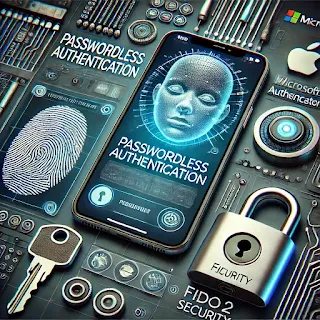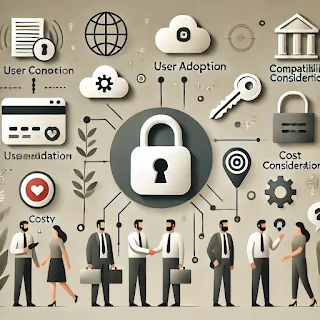Passwordless Authentication in Microsoft Entra ID
In today’s digital landscape, the
demand for secure and user-friendly authentication methods is higher than ever.
With cyber threats on the rise, traditional password-based systems are becoming
increasingly vulnerable. Enter Microsoft Entra ID’s passwordless
authentication—a cutting-edge solution designed to enhance security while
simplifying user access. But what exactly is passwordless authentication, and
how does it work within the Microsoft Entra ID ecosystem? Let’s dive in.
What is Passwordless Authentication
Passwordless authentication is an
innovative approach that eliminates the need for passwords entirely. Instead of
relying on passwords, it leverages alternative methods like biometrics,
hardware tokens, and mobile devices to authenticate users securely and
efficiently. This method not only enhances security but also significantly
improves the user experience by removing the hassle of remembering and managing
passwords.
Traditional passwords are a weak
link in security systems. They are often reused, easily guessed, or stolen
through phishing and other cyberattacks. Passwordless authentication addresses
these vulnerabilities by using more robust and user-friendly methods to verify
identity.
How Microsoft Entra ID Implements Passwordless Authentication
Microsoft Entra ID integrates
passwordless authentication seamlessly into its identity management system,
offering several methods that cater to different organizational needs. Here’s
how it works:
1. Windows Hello for Business
Windows Hello for Business is a
biometric authentication method that uses facial recognition, fingerprints, or
a PIN to sign in. This method is deeply integrated into the Windows operating
system, providing a quick and secure way for users to access their devices and
services.
2. FIDO2 Security Keys
FIDO2 Security Keys are hardware
devices that provide secure, passwordless sign-ins. These keys use public-key
cryptography to authenticate users, ensuring that only the rightful owner of
the key can access the system. They are particularly useful in environments
where strong security is required, such as in financial institutions or
government agencies.
3. Microsoft Authenticator App
The Microsoft Authenticator App
is a mobile app that can be used for multi-factor authentication (MFA) and
passwordless sign-ins. Users receive a notification on their mobile device,
which they can approve to complete the authentication process. This method is
both convenient and secure, as it leverages the device that users already carry
with them.
Benefits of Passwordless Authentication in Microsoft Entra ID
Implementing passwordless
authentication in Microsoft Entra ID comes with a host of benefits:
1. Enhanced Security
By eliminating passwords, the
risk of phishing, credential theft, and brute force attacks is significantly
reduced. Passwordless methods rely on strong, user-specific factors like
biometrics or hardware tokens, making it much harder for attackers to gain
unauthorized access.
2. Improved User Experience
Users no longer need to remember
complex passwords or worry about frequent password resets. Passwordless
authentication offers a faster and more convenient login experience, which can
lead to higher user satisfaction and productivity.
3. Reduced IT Costs
With fewer password-related
issues, such as resets and lockouts, IT departments can save time and
resources. This reduction in password management overhead can translate into
significant cost savings for organizations.
4. Compliance and Regulatory
Alignment
Passwordless authentication
supports compliance with various security standards and regulations. By
implementing stronger authentication methods, organizations can better meet the
requirements of frameworks like GDPR, HIPAA, and PCI DSS.
Real-World Use Cases
Many organizations have already
begun reaping the benefits of passwordless authentication with Microsoft Entra
ID. For example, a large financial institution implemented FIDO2 Security Keys
across its workforce, resulting in a 50% reduction in phishing-related
incidents. Another case saw a healthcare provider adopt Windows Hello for
Business, which not only enhanced security but also improved patient data
protection and compliance with healthcare regulations.
How to Get Started
If you’re interested in
implementing passwordless authentication in your organization, here’s how you
can get started:
1. Evaluate Your Environment
Assess your current identity
management and authentication setup. Identify areas where passwordless methods
could provide the most benefit, such as in high-risk or high-traffic systems.
2. Choose the Right Method
Decide which passwordless
method(s) to implement based on your organization’s needs and infrastructure.
Whether it’s biometrics, hardware tokens, or mobile app authentication, choose
the solution that aligns with your security goals and user preferences.
3. Deploy and Test
Roll out the solution in phases,
starting with a pilot group to test functionality and gather feedback. This
approach allows you to identify and address any issues before a full-scale
deployment.
4. Educate and Support Users
Provide training and resources to
ensure a smooth transition for users. Clear communication about the benefits
and steps to use the new authentication methods will help in driving adoption.
5. Monitor and Optimize
Continuously monitor the
implementation and adjust as needed. Regularly review security logs, user
feedback, and system performance to ensure the solution remains effective and
user-friendly.
Addressing Common Concerns
While the benefits are clear,
some organizations may have concerns about adopting passwordless
authentication:
1. User Adoption
Change can be challenging,
especially when it involves something as fundamental as how users log in. To
encourage adoption, focus on communicating the benefits clearly and providing
adequate support during the transition.
2. Compatibility
Ensuring that passwordless
methods work across various devices and platforms is crucial. Microsoft Entra
ID’s solutions are designed to be versatile, but it’s essential to test
compatibility within your specific environment.
3. Cost Considerations
While there is an upfront
investment in implementing passwordless authentication, the long-term benefits,
such as reduced IT support costs and enhanced security, often outweigh the
initial expenses.
Conclusion
Passwordless authentication isn’t
just a trend; it’s the future of secure access management. By embracing
Microsoft Entra ID’s passwordless options, organizations can protect their
data, improve user satisfaction, and stay ahead in an increasingly complex
digital world. Ready to make the switch? The time to go passwordless is now.
Call to Action
Interested in enhancing your
organization’s security? Explore the possibilities of passwordless
authentication with Microsoft Entra ID today.
Authentication methods and features - Microsoft Entra ID | Microsoft Learn


















0 Comments